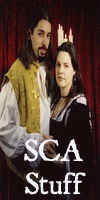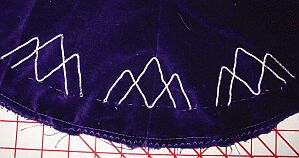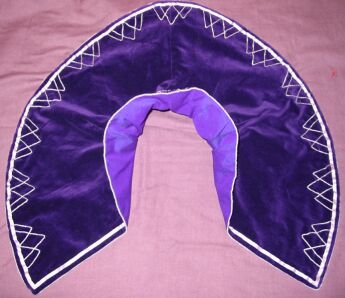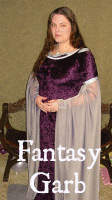Recreated by La Signora Onorata Katerina da Brescia.
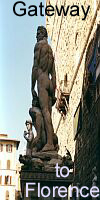  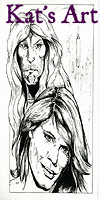 |
The mantellina was a short
cloak, often described as a cape for the shoulders or neck. It was
apparently similar to the 'gollar' worn by German women. Its main
function was warmth. It could be worn underneath or on top of longer
cloaks. La Mode a Fiorenze also
surmises that the mantellina was worn in bed or in the home for
protection against the cold.Materials used for the mantellina were:
wool, velvet or satin or
ermesino (tafetta). Prescious silks were usually preferred. The
mantellina was usually lined wtih ermine. The colour red was common, as
was gold embroidery and hungarian style frogs for closures. Documentation is found at: Mantellina This was originally made as part of a competition called 'Keeping warm'. At this time, I did not have much documentation on Italian mantellino, and based much of the pattern and information on german gollars. I still have not been able to find information on the actual pattern from Italian mantellino, other than (as expected) they were used in a similar fashion. Method: To get the fit over the back and neck, I used a 2 piece pattern with a 'gore' at the shoulder. These were sewn together, embroidered and embellished, then lined. Materials were dictated by the remains in my material stash, while trying to use period materials. The goller was made out of purple cotton velveteen, lined with Thailand (2-tone) silk, gifted to me by Master Tovye Woolmongre. Both velveteen and silk are very warm materials and should serve the purpose of 'keeping me warm' very well. (La Mode a Fiorenze states precious silks were used for mantellina)
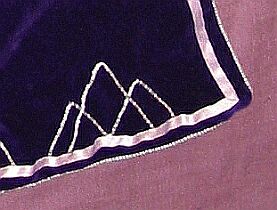 Figrure 4 close up of pearl edging /decorative treatment. Figrure 4 close up of pearl edging /decorative treatment.Decoration is the hardest thing when there is no pictorial evidence. I did add a 'frog' to the front, as this was specifically mentioned as a form of decoration for mantellino. This was also a very practicle thing, reducing the slip factor and keeping the dang thing on! Here is the finished item... 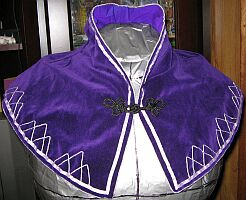 BIBLIOGRAPHY (Life in Tudor age)
For more pics:
|
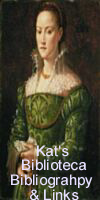 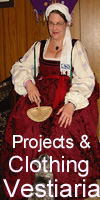  |
All intellectual content, photos and layout are copyright to La Signora Onorata Katerina da Brescia (K Carlisle), except those original renaissance artworks and extant articles whose copyright remains with the current owner.
If
you would like to use something from this site, please
contact me, and cite this website reference.
(c). K.Carlisle, 2009.
